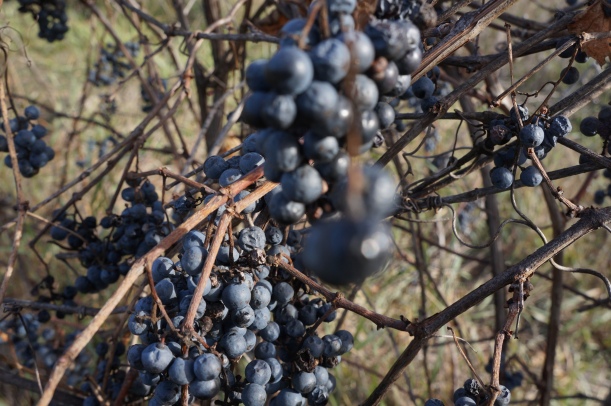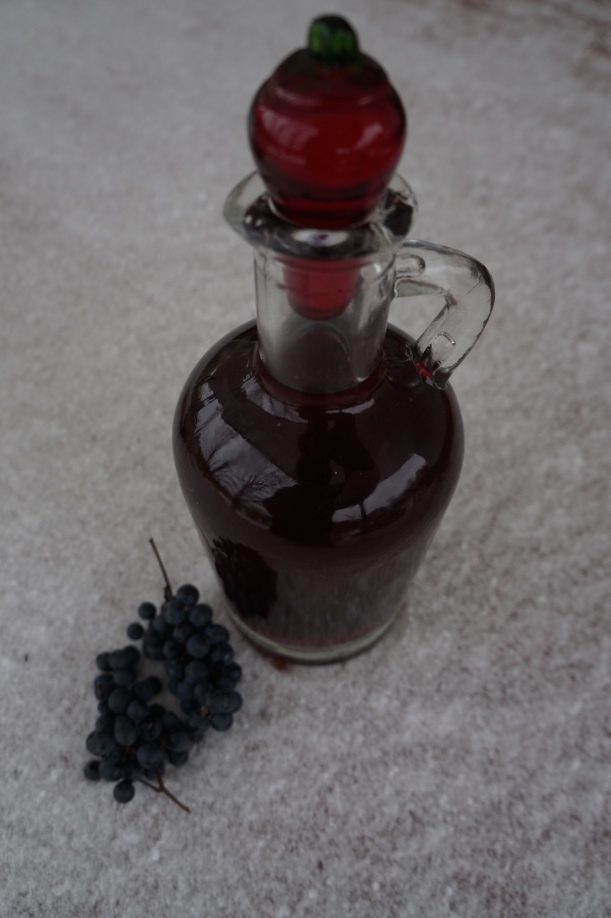 When I read today’s Fiesta Friday post, one recipe featured from last week particularly caught my eye and I decided to make it right away. Unwilling to go shopping I had to make do with either what I had in my own kitchen or garden, and by the time I finished I had used in my version, still recognizable as Monika’s, a few ‘new’ ingredients I thought worth sharing.
When I read today’s Fiesta Friday post, one recipe featured from last week particularly caught my eye and I decided to make it right away. Unwilling to go shopping I had to make do with either what I had in my own kitchen or garden, and by the time I finished I had used in my version, still recognizable as Monika’s, a few ‘new’ ingredients I thought worth sharing.
The recipe I refer to is one for Pomegranate Beet Salsa by Monika at Everyday Healthy Recipes. It is the perfect dish for these hot dry days- simple to prepare, keeps well, and as good on its own as it is a side dish. Thank you Monika!
The so-called new ingredients in my recipe are red currants (ribes rubrum) and Queen Anne’s lace (daucus carota) leaves. The currants I have used before to make salad dressing and mayonnaise, but I had never thought of putting them whole into a salad. They are found in much of North Eastern US and Eastern Canada. Once established they thrive in sunny spots, and apparently are drought resistant given that they are still thriving in our back yard desert. One source I read describes them as a brilliant red skin encasing a pulpy flesh that contains 3-12 tiny edible seeds with flavours of raspberry, cranberry, gooseberry, rhubarb and a hint of rose. That sounds about right to me. Many sources say they are delicious as long as you add lots of sugar, which explains why they are most often used to make jelly. However, used sparingly in a savoury dish such as this one, no sugar is needed.
As for the Queen Anne’s lace, there is so much of it blooming right now, but I had not given any thought to anything other than the flowers. I know that all parts of the plant are edible and often see reference to the leaves as being good in salads, but have never seen a salad recipe that calls for them. For identification and further information on this plant, please check here.
Again, the herbs I used are all from my garden, but this salad is versatile, and you can make your own mix of greens to add. As for the oil, I used my black walnut infused oil, and I think any nut oil would be good, or just a good quality oil as Monika suggests, such as grape seed oil.
Beet and Red Currant Salad
3 Tbsp finely chopped red onion
3 Tbsp balsamic vinegar
2 cups chopped beets, previously boiled, cooled and peeled
2 Tbsp chopped Queen Anne’s lace leaves
1 heaping Tbsp each of fresh mint and dill
2 Tbsp oil
salt and pepper to taste
3/4 cup red currants
Put the onion and vinegar in a bowl and allow to sit while preparing the other ingredients. Add everything except the currants and mix well. Gently fold in the currants. Refrigerate for at least an hour before serving for best flavour.
 Linked to: Fiesta Friday #233
Linked to: Fiesta Friday #233




 I consider myself very fortunate to have a crabapple tree growing in our front lawn, just steps away from our verandah. In the spring it produces showy pink blossoms, and the tiny red apples that appear in summer last well into the winter, although I only pick them before the first hard frost. The rest are for the birds – literally! The other day the tree was visited by some grey jays (aka whiskey jacks) which may soon be Canada’s new national bird emblem, and some winters bohemian wax wings pay us a visit. If the seedlings I transplanted survive this winter, I hope to have a few more of this magnificent tree in the future.
I consider myself very fortunate to have a crabapple tree growing in our front lawn, just steps away from our verandah. In the spring it produces showy pink blossoms, and the tiny red apples that appear in summer last well into the winter, although I only pick them before the first hard frost. The rest are for the birds – literally! The other day the tree was visited by some grey jays (aka whiskey jacks) which may soon be Canada’s new national bird emblem, and some winters bohemian wax wings pay us a visit. If the seedlings I transplanted survive this winter, I hope to have a few more of this magnificent tree in the future. This jelly is thicker than most, perfect for using as a filling. I also use it to add to dressing, marinades and sauces. This time I chose to make something resembling date squares but substituting them for the more exotic dates.
This jelly is thicker than most, perfect for using as a filling. I also use it to add to dressing, marinades and sauces. This time I chose to make something resembling date squares but substituting them for the more exotic dates. 

 A delicious adaptation of lemon curd, this wild grape dessert has just as many uses. By using fresh or frozen wild grape juice, it is ready in a matter of minutes. It can be used as a topping for pound cake, ice cream or baked in tarts or pastry or even just as is – it’s that good. All you will need is a few wild grapes which are available now for the picking!
A delicious adaptation of lemon curd, this wild grape dessert has just as many uses. By using fresh or frozen wild grape juice, it is ready in a matter of minutes. It can be used as a topping for pound cake, ice cream or baked in tarts or pastry or even just as is – it’s that good. All you will need is a few wild grapes which are available now for the picking!
 In a
In a  Related posts:
Related posts:  This has been a great year for apples – so good in fact that I have heard pleas on the radio for people to do the trees a favour and pick the fruit because the branches are breaking from the weight. The fruit may be smaller than usual because of the horrific drought, but they are more numerous and, even better, sweeter than ever.
This has been a great year for apples – so good in fact that I have heard pleas on the radio for people to do the trees a favour and pick the fruit because the branches are breaking from the weight. The fruit may be smaller than usual because of the horrific drought, but they are more numerous and, even better, sweeter than ever.


 Serve hot garnished with sour cream or apple slices.
Serve hot garnished with sour cream or apple slices.
 The best way to extract the juice from these berries is to cook them in a pot with a little water for a few minutes, then strain them. The less water you use, the better, but be sure to use enough the pot doesn’t boil dry.
The best way to extract the juice from these berries is to cook them in a pot with a little water for a few minutes, then strain them. The less water you use, the better, but be sure to use enough the pot doesn’t boil dry. Don’t worry if it looks a little runny – it will thicken as it cools. Store any leftovers in a covered jar in the fridge where it will keep for at least 2 weeks. This recipe may even be the biggest hit of your festive dinner this year.
Don’t worry if it looks a little runny – it will thicken as it cools. Store any leftovers in a covered jar in the fridge where it will keep for at least 2 weeks. This recipe may even be the biggest hit of your festive dinner this year. Light and airy, sweet and tart, this dessert is based on a classic I have not made or even seen in a while. For some reason the strong flavour and colour of the now ripe chokecherries is perfect for this otherwise bland pie.
Light and airy, sweet and tart, this dessert is based on a classic I have not made or even seen in a while. For some reason the strong flavour and colour of the now ripe chokecherries is perfect for this otherwise bland pie.
 Linked to
Linked to 



 I have been wanting to make this recipe for some time now ever since I saw it on one of my favourite cooking shows on PBS, A Chef’s Life with Vivian Howard. Her recipes are very straight forward, and her attention to ingredients, always local and usually inspired by her own regional cuisine of N. Carolina is what draws me to her programme.
I have been wanting to make this recipe for some time now ever since I saw it on one of my favourite cooking shows on PBS, A Chef’s Life with Vivian Howard. Her recipes are very straight forward, and her attention to ingredients, always local and usually inspired by her own regional cuisine of N. Carolina is what draws me to her programme.






